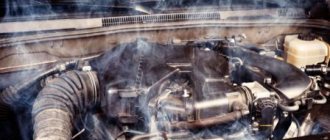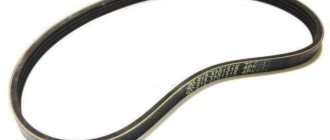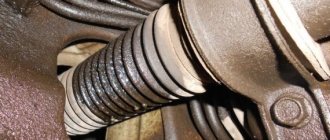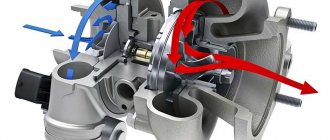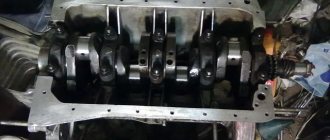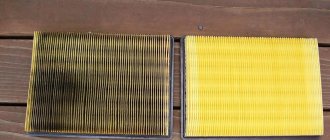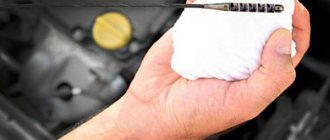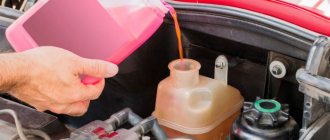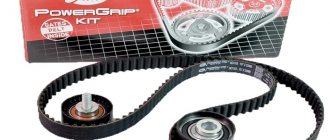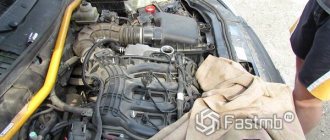Engine oil starvation - a situation in which the oil level in it is below the permissible level. As a result, individual components and parts of the motor do not receive enough lubrication. This leads to significant wear and overheating, which in turn can cause complete or partial engine failure. These arguments are valid for both gasoline and diesel engines, including turbocharged ones. Therefore, in this material we will look at the signs, causes and consequences of oil starvation, as well as common myths associated with this phenomenon. We hope that this information will subsequently be useful to you and will help protect your car’s engine from this negative process.
Signs of oil starvation
This phenomenon is quite easy to identify. There are a number of direct and indirect signs indicating the presence of oil starvation. However, be aware that some of the symptoms described below may indicate another problem. But the first thing you should do is check the engine oil level.
- Glowing oil pressure lamp on the dashboard . It must be remembered that the corresponding sensor is triggered in advance, when the critical oil level in the engine is still far away. At the initial stage, only the oil scraper rings are at risk. However, you should not delay this. Immediately after the lamp comes on, check the oil level.
- Car jerking when driving . Loss of its dynamic characteristics.
- The appearance of blue smoke from the exhaust pipe.
- In some cases, clanging or whistling sounds appear . This is especially true for turbocharged engines.
If at least one of the listed symptoms is detected, you must first check the oil level . However, do not rush to top it up. Topping up will help only in the initial stages of fasting (when the lamp on the panel lights up). If the engine has been running “hungry” for a long time, then topping up alone is not enough. We need detailed diagnostics at a service station.
Lubricant starvation
Reasons for lack of engine fluid pressure
The oil pressure indicator light starts to burn - the pressure of the engine mixture in the engine is insufficient.
In most situations, it lights up for a few seconds, then goes out: there is no cause for concern. For example, the indicator lights up during a cold start of the power unit, at a low temperature outside the car. A similar situation occurs after a scheduled replacement of the engine fluid - after the first start of the engine, the pressure indicator lights up for several seconds. If the light is on and does not go out: you need to look for a breakdown. Watch the video about the reasons for the lack of engine mixture pressure:
After making sure that the sensor is on and does not go out, check its serviceability. To do this, instead of a sensor, connect a lancet pressure gauge to the system. Then start the engine, look at the pressure gauge readings - normal pressure is not less than 0.4 MPa. If the measurements are lower, the probable reasons for the sensor to trigger are:
Check the condition of the device, the pump may be broken and needs to be replaced.
Causes of oil starvation
There are several reasons why this phenomenon occurs. Among them:
- Untimely addition of oil .
This is the most common reason. Often, car owners simply forget to regularly check the engine oil level using the dipstick designed for this purpose. After all, any engine, even the most modern one, gradually “eats up” oil. Therefore, the level must be monitored regularly. For each vehicle, the frequency of appropriate inspection is determined by its manufacturer. However, on average, this procedure needs to be performed approximately once a month or even more often. It is worth remembering that overfilling the engine oil also negatively affects the operation of the power unit. - Untimely oil change . Over time, during operation, the oil thickens, becomes dirty and loses its technological properties. The consequence of this is clogging of the oil passages in the engine, as well as the oil filter. Because of this, the engine components do not receive enough lubrication, that is, oil starvation occurs.
- Poor quality oil . If you bought a fake, then there is a high probability that the service life of the lubricant will end prematurely, and accordingly, the oil will lose its properties. In particular, it thickens, becomes dirty and blackens. A situation may also arise when it initially does not have the necessary properties. To avoid this situation, try to make purchases in trusted stores that have the appropriate licenses.
- Non-compliance with the car manufacturer's requirements . In particular, we are talking about a situation where a car owner or a car service worker fills the engine with oil of the wrong viscosity and tolerance. Therefore, when choosing a lubricant, it is imperative to take into account their labeling, as well as other requirements of the car manufacturer.
- Reduced oil pump performance . This can happen for various reasons. For example, clogging of its impeller, failure of bearings, aging of the unit, and so on. In any case, check its functionality.
As you can see, in most cases the main cause of oil starvation is ordinary human negligence and untimely or insufficient vehicle maintenance. In turn, this can lead to very sad consequences and expensive repairs.
NICEs Blog If the engine oil level is too low
The lubrication system is designed to reduce friction between the rubbing parts of the engine. In addition to performing its main function, the lubrication system provides cooling of engine parts, removal of carbon deposits and wear, and protection of engine parts from corrosion. Therefore, malfunctions in the engine lubrication system are very dangerous. We will talk about what to do if the engine oil level is higher or lower than the normal level and what the consequences may be.
If the engine oil level is below normal
It happens that the oil level in the engine crankcase is below normal. This can be checked using a dipstick no earlier than 5-7 minutes after stopping the engine. The oil level should be considered normal if the mark on the dipstick is halfway between the min and max marks.
If the check shows that the oil level is below normal, add oil to the engine crankcase to the required level, having previously identified and eliminated possible leaks in the connections in the engine lubrication system. By externally inspecting the engine, you can verify whether there are oil leaks from under the gaskets - camshaft drive cover, valve cover, cylinder block, oil filter, as well as from the filler plug, through the oil pressure indicator sensor fitting from under the oil separator cover and through the oil dipstick seal.
Even small oil leaks detected indicate a violation of the tightness of the lubrication system due to damaged gaskets or seals or unreliable fastenings, which is absolutely unacceptable.
If the engine oil level is higher than normal
High oil pressure is no better than low oil pressure: most likely, the problem is in the viscosity of the oil used; to do this, you need to check its viscosity and quality, and if necessary, replace the oil. It is common to see increased oil pressure when using summer oil in winter at low temperatures.
In the engine lubrication system, the required pressure is provided at normal viscosity. Therefore, for each engine, depending on the season, ambient temperature and dustiness of the area, manufacturers recommend a certain type of oil that has a certain viscosity and the necessary lubricating properties.
During the operation of the car, partial dilution of the oil occurs with that part of the gasoline that does not burn when the engine is running on an over-enriched mixture, or sometimes due to coolant getting into the oil when the cylinder head gasket is damaged. Of course, the quality of the oil decreases and its viscosity decreases if the oil is old and has long been in need of replacement. The oil pressure in the lubrication system decreases sharply, because Low-viscosity oil easily penetrates into the gaps between mating rubbing parts.
To ensure a long service life of engine oil with the required viscosity and required quality, I recommend that you regularly monitor the serviceability of the crankcase ventilation system and promptly clean it and flush the parts.
If you have filled the engine oil above the level
There are situations when more oil is poured into the engine during the next replacement, and more often this happens due to inattention. What happens if you fill the engine with more oil than normal? Is it worth draining it? If you filled the oil slightly above the “max” level on the oil dipstick, then it’s okay. During operation, the oil will drain naturally and after several thousand kilometers, the oil level will be normal.
If you have filled in too much oil above the norm, then problems may arise. Especially if you already have an old car. When the oil level is higher than normal, increased pressure is created in the lubrication system, and this can lead to wear on the seals and subsequently they can be “squeezed out”.
It is advisable not to exceed the recommended oil level. And if there is a large amount of “excess” oil in the engine, then it is advisable to drain it to normal.
Consequences of low oil level
The consequences of oil starvation can be the most unpleasant for the car owner. At the same time, you need to remember that the longer the car is driven with a small amount of oil in the engine, the more serious they will be. After all, an emergency situation can occur very quickly, literally in a matter of minutes. Let's list the announced consequences:
What are the dangers of oil starvation?
- Failure of oil scraper rings . A sign of this phenomenon will be the car jerking while driving, as well as blue smoke from the exhaust pipe. This happens because oil enters the engine cylinders.
- Damage to the upper camshaft . Due to the fact that it rotates without lubrication, and its angular velocity is quite high, the shaft expands in diameter and can simply jam.
- Damage to the crankshaft . The situation is similar to the previous point. Shock loads at high temperatures lead to bending of the shaft, as well as eccentricity of the journals. The worst thing is that this cannot always be corrected by grinding to the repair size.
- Engine pistons jamming . This is one of the most terrible phenomena in this vein, since there is a high probability that a large piece of the engine block will be torn out. And eliminating the consequences of such an accident is extremely difficult, if not impossible. It is much easier to buy a new engine.
- The half rings may become welded to the surface of the crankshaft . The consequence of this is the rotation of the liners with damage to the seats in both the cylinder block and the lower covers of the main bearings. Also, if the connecting rod bearings rotate, scuffing will occur on the crankshaft journal and significant wear on the holes in the lower part of the connecting rod.
- Damage to the geometry of the camshaft bed , as well as their supporting surfaces, is possible. In most cases, their repair is impossible.
- Deformation of the liners , both connecting rod and main bearings, with fusion of the upper sliding layer (usually made of babbitt).
- Destruction of honing from cylinder mirrors.
Result of water hammer - The so-called “fist of friendship” . This refers to the situation when a failed connecting rod breaks through the crankcase wall. This is the reason for the complete failure of the cylinder block and its irreparability.
As you can see, such a seemingly trifle as an untimely oil change can lead to significant problems with the engine and expensive repairs.
Diesel engine oil starvation
For a diesel engine, the reasoning described above is also valid. The oil level in the engine must not be allowed to drop significantly. The causes of oil starvation may be:
- Untimely oil change.
- Low quality lubricant.
- Insufficient oil pump performance.
- Increasing the gaps between individual engine elements.
- Oil filter clogged.
- Using the wrong oil.
- Oil dilution by coolant or fuel. This can happen in case of severe engine wear, when at least one cylinder is completely or partially out of order.
Therefore, follow the recommendations above, and do not forget to monitor the level and condition of the oil in the system. In addition, remember that usually in diesel engines the process of changing the lubricant occurs more often than in gasoline engines. Check the replacement regulations in your car's manual.
Is it possible to drive when the oil is at the minimum level?
Experts answer this unequivocally and simply: it is possible, but you should not accelerate and drive for a long time. The oil volume in the engine itself is enough for a short run, without serious loads. There is no need to drive at high speeds, or try to climb a high mountain or slide down a slope.
Also, the minimum indicator does not mean at all that the oil pressure in the engine itself has dropped. This will be clear when the light on the instrument panel comes on, and there is nothing good about that. If you don’t have oil with you and you can’t add oil, you need to:
- make sure that there is oil in the crankcase, even in a minimal amount;
- look at the pan, it may probably break through, make sure that the pipes are intact and there are no leaks. Inspect the engine for oil stains;
- build a route to a service station/gas station/store that is nearby.
The main thing is to take into account the gentle operation of the motor.
Turbine oil starvation
Turbine operation under oil starvation conditions is unacceptable ! Even short-term. The fact is that its shaft rotates at enormous speed, greater than the engine itself. Therefore, for the turbine shaft, the problems described above are even more relevant. If at one point its shaft rotates without lubrication, it will jam very quickly and the turbine will simply fail. In particular, the turbocharger bushings and shaft fail.
Damaged turbocharger surfaces
However, the bearings are the first to suffer . When they fail one after another, mutual friction of the turbine and compressor rotors occurs, as well as wear of the sealing rings. In the worst case, the turbine shaft may break.
The normal operating temperature of the bearings is +60°…+90°С. Therefore, heat transfer is very important, and its disruption due to the effect of oil starvation leads to significant heating of the turbine shaft. And given that heat also comes from the turbine wheel, the shaft temperature can reach +400°C. Due to this temperature, the process of coking of the remaining oil on the shaft occurs. The holes supplying oil to the bearings and the middle turbine housing are also clogged with coke. And this contributes to even greater oil starvation.
That is, due to the operation of the turbine in a dry state, the bearings quickly wear out, and foreign metal deposits appear on the shaft. The clearances in the bearings increase, resulting in shaft play. Also, due to the gaps in the bearings, a process occurs when the compressor and turbine impellers first select a gap between the housings, and then simply rub and wear out against them. The consequence of this is an imbalance that increases over time. And this is essentially the “beginning of the end” of the turbocharger. Usually, in this case, the turbine makes additional “unhealthy sounds” - a loud whistle, grinding, howling.
Result of turbine wear
Turbochargers have three types of oil starvation:
- Fast (or sharp). A sudden appearance of oil starvation can be caused by several reasons - a break or bend in the oil supply tube, a malfunction of the oil pump, or oil leakage from the system. Here we can also note the so-called “dry start”. It can happen if the compressor is installed incorrectly after repair or after purchasing a new unit. In particular, in this case, an air plug may form in the middle spring housing, which the oil cannot push through, which is a natural cause of oil starvation.
- Smooth (or slow). In this mode, the turbine constantly operates with a slight lack of oil volume. There can be many reasons for this - low performance of the oil pump, coking of the oil line, slight bending of the tubes, use of oil with inappropriate viscosity. Slow starvation is a slow failure of the turbine. Therefore, always monitor the normal operation of the listed components.
- Periodic (or cyclical). This is usually caused by improper operation of the engine. In particular, its sudden stop after a large and prolonged load. The fact is that at high speeds the turbine and other elements become very hot, and their cooling is provided by oil. And if the engine is turned off, the movement of oil will stop. The consequence of this is the heating of the lubricant remaining in the system and its coking. Because of this, the oil channels become clogged, and their cross-sectional area, and therefore productivity, decreases. Thus, the owner himself slowly “kills” the engine. To prevent this from happening, after significant loads on the engine, it is necessary to let it run for several minutes so that it cools the turbine.
It is also important for the turbine that the oil is clean and of the appropriate consistency (not thick).
Common Myths About Oil Fasting
There are several popular myths and misconceptions that are common on the Internet and among car owners. We will try to debunk them and shed light of truth on the questions that arise for many.
- The amount of sealant applied when installing the valve cover or pan does not in any way affect the operation of the oil pump. And moreover, the more of it, the better, since supposedly the fit is tighter. This is actually a huge misconception! After all, its excess will be partially squeezed inward, as a result of which it will definitely get into the lubrication system. Which threatens to clog the oil channels, pressure relief valve and oil receiver mesh.
- There are miracle additives that allow the engine to run without oil at all. In fact, such compositions only create a protective film for rubbing surfaces. And supposedly the test results are presented for engines running without load (at idle speed). Therefore, double-check the composition and functions of such additives before use, and even then, use them only with a normal engine oil level.
- There is also another common myth that when changing the oil, it must also be added directly to the oil filter. This is explained by the alleged oil starvation of the engine. This statement is only true if the outside temperature is -25°C and below.
On powerful diesel engines, the design provides for a preliminary lubrication system before starting, so that in winter it has the required viscosity and prevents oil starvation.
Does the motor run without lubricant?
On advertising stands, there are cars whose drives operate without oil, the pan is completely removed. This situation is of interest; because of it, drivers believe that a low level of engine fluid in the system is not a problem. This opinion is wrong. The operating mode of the machine on the advertising stand differs from the actual operating conditions of the power unit:
Additional Tips
Finally, we will summarize the information for you, and also provide a few additional tips that will allow you to avoid the unpleasant consequences of engine oil starvation.
- Don't forget to check the engine oil level regularly. Top it up if necessary.
- Monitor the condition of the oil. Change it according to the car manufacturer's recommendations. If it has become significantly blackened and thickened, it should be replaced before the next maintenance.
- Change the oil filter on time. It is better to buy original products or their high-quality analogues. Avoid fakes. Never buy filters whose filter element is made of cardboard.
- In the cold season, after starting the engine, do not give it high speeds. Let it warm up normally in idle mode first. It is also advisable to drive at low speeds at first in severe frost. This is due to the fact that it is much more difficult for the pump to move thick, cold oil through the system. And this is a natural cause of oil starvation.
These simple rules will help you avoid costly repairs and operate your car for many years.
